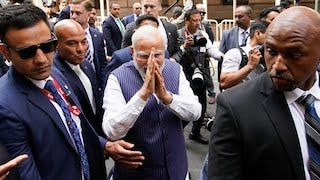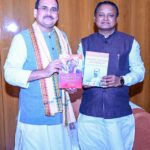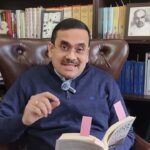Modi in US: How Narendra Modi’s visit to US marks India’s self-discovery after 75 years
- By : Anirban Ganguly
- Category : Articles

Modi in US: Prime Minister Narendra Modi’s state visit to the US symbolises India’s empowered journey of self-expression which has been in the making for 75 years
As Prime Minister Narendra Modi embarks on a historic visit to the United States much is being written about the visit, its prospects, potential and the future it hopes to build between two of the greatest democracies of the world. This meeting between the high representatives of the world’s youngest democracy and the mother of democracy will be a symbolic moment which will define the course of global realignments for quite some time to come. It has been pointed out that Prime Minister Modi will be the first Indian prime minister to address the US Congress twice and the fifth world leader to do so. It is clear that this will not be another customary address but a defining one. In his first address at the US Congress Prime Minister Modi had spoken of ‘overcoming hesitations of history’, his second address promises to delineate India’s world dream and its contours and hopes.
Among the many stand-out characteristics of this visit are two, it is a confident and emerging India that the West is increasingly looking to that will be represented on this visit, two, this is the first Prime Ministerial visit while India commemorates the seventy-fifth year of her independence. The fundamental values of a struggle for freedom from foreign subjection are almost identical across continents, ages and ideologies. It is these values of freedom and independence that has and can further form the bedrock of a lasting intellectual and ideational partnership between India and the US.
When India’s first prime minister embarked on an extensive tour of the US in 1949, it was as the representative of a newly independent country, hesitant, hopeful and tentative. When PM Modi embarks on his US visit in the summer of 2023, it will be as the leader of an India which has overcome hesitations, given up on tentativeness and has been able to proffer solutions to problems of global proportions repeatedly. It will be as the leader of an India that is assertive, pragmatic, intense and determined to keep leaving her mark on world events, he will embark as the voice of an India that is being increasingly recognised as a force, an entity of stability, balance, as the articulator of the hopes of the marginalised, as an empowered entity with a philosophy that is backed by strength and conviction.
For those of us who hark back to the past to join the dots and try and discover the symbolism of partnership across time, Prime Minister Modi’s visit to the United States of America, at a time when India has and continues to commemorate the seventy-fifth year of her independence, brings to mind those who, through their intellectual and political activism, helped sustain, in the United States, the Indian aspiration for freedom. Especially those Indian thought and political leaders who made the US their base or visited that country and advocated the hopes, aspirations and essence of India and those Americans who unfurled in their free country the banner of India’s revolution.
Among the first to come to mind is Swami Abhedananda, Vivekananda’s spiritual brother and Sri Ramakrishna’s disciple. The impact and imprint of Swami Abhedananda’s “Brooklyn Lectures”, for instance, delivered in 1905-1906 at the Brooklyn Institute of Arts and Sciences, on philosophy, religion, society, government, education and culture of India can never be forgotten. No other Indian of his time, writes Abhedananda’s biographer, Moni Bagchee, “had vindicated the cause of India as Abhedananda had done.” His Brooklyn lectures which aroused great interest in the American intelligentsia, the Americans came to know the “real conditions of India from a native of the soil who keenly felt the wrongs and sufferings of his own people and many had to revise their general impression.”
His Brooklyn lectures presented Abhedananda as the “most formidable champion of Indian culture and civilisation”, through these lectures the “patriot emerged out of the preacher” and from 1905, he “fought almost single-handed with unabated zeal and undaunted heart for the cause of India” in America. Acceding to persistent requests from the American public for publishing these lectures in book form, “India and her People” appeared in 1906. It received wide acclaim in the US and was promptly proscribed by the British in India. In his introduction to Abhedananda’s volume, Franklin Hooper, then Director of the Brooklyn Institute of Arts and Sciences, observed that the lectures constituted “an exceedingly valuable description of the social, political, educational, and religious conditions of India. They contain precisely what the American wants to know about India. Delivered, as they were, by a native of India, they are not coloured by foreign prejudices. I am impressed, by what I heard of the lectures, with the fact that in the hurry and bustle of our’ Western civilization we have a great deal to learn from the East.”
One must recall Lala Lajpat Rai’s sojourn as a political exile in America between 1914 and 1919. These were years he successfully used to rouse interest in the American mind towards India’s political subjection and plight. One of the towering members of the revolutionary triumvirate of Lal-Bal-Pal, Lajpat Rai was “almost 40 years old when he came to America”. His decision to “come to America from England”, writes American historian Harold Gould, was motivated by a determination to elicit greater overseas support for the freedom movement.” Besides founding the India Home Rule League of America, Rai also launched “Young India”, a monthly magazine, to disseminate among American statesmen and intelligentsia a “correct knowledge of Indian affairs” and set up the Indian Information Service. A determined and sustained effort saw Rai gradually “rise as a credible spokesman for Indian freedom and South Asian human rights”, it was also the result of his “ability to acquire a voice in the New York media and academia.”
NS Hardikar, freedom fighter, then president of the Indian Students Association of America, studying at the University of Michigan, at whose invitation Rai had come to the US recalled, how at first “local newspapers were reluctant to publish his articles and statements”, how it was “difficult to find hosts for his public talks,” until his book “Young India: an Interpretation and a History of the Nationalist Movement from Within”, appeared in 1916. “Lalaji’s name”, writes Hardikar, “slowly captured the minds of Americans through this book and its reviews published in the American press.” The first edition was sold out within eight months, a second edition appeared in 1918 and Rai “got slowly acquainted with Americans, and the local newspapers started giving suitable publicity to his articles. He “began to get speaking engagements and “they were followed by educational institutions, Chancellors of Universities and students. Lokmanya Tilak, his inseparable political colleague and founder of the Home Rule League of India, also sent him the support of $5,000 through Annie Besant to continue with his propaganda in support of India’s home rule.
Rai’s leading American publisher BW Huebsch, became a good friend and his book was “widely praised among journalists, scholars and educated layman.” From his New York perch, Lala Lajpat Rai, Gould pointed out, “With the help of his numerous American allies in the liberal establishment, was able to establish a lecture circuit which spanned the United States. This would become an increasingly crucial resource as time passed, because it would afford opportunities for a host of Indian freedom fighters” over the years, to “impact on American audiences”. In December 1919, when he eventually left America, Lala Lajpat Rai was given a grand farewell, with journalist Oswald G Villard, then editor of the Nation, founder of the American Anti-Imperialist League, describing Rai, as a “wise, brave, sound ambassador, a generous and moderate interpreter of great races to our American Democracies”.
To the narrative of India’s freedom struggle in America, along with Lajpat Rai’s American sojourn, the Ghadr Party and Lala Hardayal’s political activism must also be remembered. These have been amply discussed, but often forgotten, is, for instance, the contribution of revolutionary Taraknath Da’s, to the creation of the Indian narrative in America. An emissary of revolutionary Jatindra Nath Mukherjee – Bagha Jatin – Taraknath Das founded in San Francisco the League for the Independence of India, along with Panduranga Khankhoje, Lokmanya’s political disciple, who had already enrolled himself in the Washington State University and Ramnath Puri, a freedom fighter from Punjab, who had moved to the United States as a political exile sometime in 1906.
The express object of the League for the Independence of India, observed historian of the pre-Gandhian phase of the Indian freedom movement, Prithwindra Mukherjee, was “to unite the Indian emigrants, to give them an exact idea of their rights, to serve as their mediators to the American authorities and, especially, to remind each of them of their duty towards the Motherland.” Taraknath’s paper ‘Free Hindustan’ and its Gurumukhi translation ‘Swadesh Sevak’, saw wide distribution among Indians in Canada, USA and Europe. Over the years Taraknath Das would emerge as one of the most credible voices among American lawmakers of the cause of India’s freedom and the rights of Asians in America, their adopted land.
Gurudev Rabindranath Tagore undertook five visits to the US and spent a total of 17 months in that country. His last visit in 1930 left a lasting imprint on the American mind. Interestingly the poet arrived from Russia where he had a “crowded programme” with visits to many institutions and meetings with many celebrities. An exhibition of the poet’s paintings was also held in Moscow. A Tagore Reception Committee was formed in the US with lawyer diplomat Henry Morgenthau as Chairman. The American Friends Service Committee organised his stay and lectures. The poet met the American Poet Laureate Robert Frost, this was their second meeting and on 25 November, writes Tagore’s biographer Krishna Kripalani, “A banquet at the Biltmore Hotel in New York was given in his honour by 350 leading citizens of the City”. Among those who attended and felicitated the poet were former US President Calvin Coolidge and American author and playwright Sinclair Lewis who had just won the Nobel Prize.
Tagore’s response to this “gesture of American greeting” was moving and thought-provoking, “pleading for a greater understanding of India’s problems, predicaments and aspirations”, the poet invited the West to “complete the voyage to India. Come in the proper spirit and claim your share. The things that have eternal value belong to all humanity and all times. Come to us, accept us, acknowledge us, and realise that we are all brothers.” Exhibitions of his paintings were held in New York, Boston and Washington and the poet was “received by President [Herbert] Hoover at the White House.” His meetings with Helen Keller and American historian and a steadfast friend of India, Will Durant, were inspiring.
Inscribing a copy of his book, “The Case for India” (1930) which was banned by the British in India, Durant movingly wrote to the Poet, “You alone are sufficient reason why India should be free.” In concluding his opuscule on India’s political subjection which was creating waves among the thinking public in the West, Durant had written, ‘it is hard to be without feeling, not to be moved with great pity, in the presence of 320,000,000 people struggling for freedom, in the presence of a Tagore, a Gandhi, a Jagadis Chandra Bose, a Sarojini Naidu, fretting in chains; there is something indecent and offensive in keeping such men and women in bondage. To be neutral in this matter is to confess that we have lost every hope and every ideal, and that our American experiment, and indeed all human life, have become meaningless.”
Keller bidding farewell to the poet, having attended his talks spoke of his philosophy and world-view as a bridge which was a “symbol of the bond of justice that shall unite East and West, North and South.” Beautiful shall be, she wrote, “the feet of those who cross and re-cross it with tidings of fellowship and peace.” Einstein who had just arrived on a visit to the US at the same time sent a radiogram message for the Poet who was then addressing a 3,000-strong audience at the Ritz-Carlton, under the auspices of the “New History Society’, “May Tagore work further,” Einstein’s message read, “with success in the services of our ideals for the union of all nations.” It was the poet’s last and most successful American visit, it helped to further deepen India’s cultural narrative in the West.
JT Sunderland, another American, a close friend of Durant, whose contributions and activism for the cause of India’s freedom had helped sensitise a wide cross-section of American opinion to India’s struggle must also be remembered with gratitude. Sunderland’s book “India in Bondage: her right to freedom and a place among the great nations” which appeared in 1929, was an instant hit with the American intelligentsia. Over the years, Sunderland had emerged as a key opinion maker and influencer for disseminating Indian opinion in the US. Of his “India in Bondage”, Sunderland wrote, “it is a comprehensive study – outspoken and fearless, but earnestly endeavouring to be fair and just – of British rule in India from the side of the Indian people – from the side of the people who are compelled to bear the galling yoke of bondage to strangers, and who with ever-increasing earnestness declare the yoke intolerable. Will the world hear facts? Will England? Will America?” Sunderland argued, how “for 2,500 years India was pre-eminently the intellectual and spiritual teacher of Asia, which means half of the human race.”
Sunderland’s question to the West, to Americans was unequivocal, “For 2,500 years before the British came on the scene and robbed her of her freedom, India was self-ruling, and one of the most renowned nations of the world. Such is India. Should such a nation be held in bondage? Has not such a nation a right to liberty, to self-government, and to a place once more, such as she occupied for so long, among the great nations of mankind?
There are numerous personalities and figures in the history of India and US relationship who have contributed in numerous ways to imagining, shaping and radiating the India narrative in the West at various times. Of Swami Vivekananda, Thoreau who was perceived to be a Yogi by some, and of Emerson, whose “life of spiritual dignity” and whose writings were permeated “through and through by the Indian spirit”, there is ample writing and contemplation. There are others who have been layered over in the midst of the past. It is to all of them that we need to return periodically so that the texture of this partnership is redefined and sustained.
Addressing a gathering at the Philip Brooks House, Harvard University, on 15 August 1947, Ananda Coomaraswamy, iconic cultural philosopher and interpreter of India who had made America his home for three decades as the keeper of Indian art at the Boston Fine Arts Museum, spoke candidly and inspiringly, “Our problem is not so much one of the rebirth of an Indian culture, as it is one of preserving what remains of it.” Coomaraswamy spoke of an “immediate and desperate need for the establishment” by a free India, of “cultural, and not merely economic and political contacts with the rest of the world…” “I have been asked”, he told his Harvard audience, ‘What is your message to the new India of our dreams?’ This is my answer: ‘Be yourself.’”
It is as the proud leader of an India which has determinedly begun to be herself, that Prime Minister Narendra Modi is visiting the United States, 75 years after that hope was articulated.
The author is a Member, BJP National Executive and Director, Dr Syama Prasad Mookerjee Research Foundation. Views expressed are personal.

















